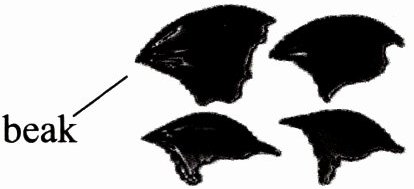A
For many animals, an island can be a great place to live. Water all around keeps big predators away. But islands have their own dangers. Food and water are limited. A storm or volcano can easily wipe out a whole population or change the land in big ways. If a predator (like cats or rats) does arrive, there's no escape. These challenges can cause island animals to evolve (进化) quite differently from their mainland ancestors (祖先). So, islands around the world are home to rare species found nowhere else. ①

Finches from the Galápagos beak
The Galápagos are a group of small volcanic islands in the Pacific Ocean, 600 miles (966 km) west of Ecuador. When these islands first erupted (喷发) from the sea, they were empty of life. Over time, plant seeds blew or drifted there. Birds arrived, bringing more seeds. Tortoises and iguanas (鬣蜥) floated over on logs. ②
When scientist Charles Darwin visited the Galápagos in 1835, he noticed something interesting. Many of the islands had similar animals—iguanas, land tortoises and small birds. But these animals were a bit different on each island. On one island, birds called finches had long, narrow beaks—right for catching bugs. But on the next island, the finches had short, strong beaks. That island had more seeds, and fewer bugs. Each type of finch had a beak that matched the most common food on its island. He found similar differences in the tortoises and iguanas. ③
After thinking about this for many years, Darwin's observations led him to a startling new idea. He realized that each family of animals probably shared a common ancestor—the original birds or turtles who flew or drifted there. Gradually, as they spread to different islands, the young with traits that best suited the food on that island did better. But since each island was different, the birds or turtles on each island evolved slightly different traits. He called this idea "natural selection". ④
Darwin's idea explains more than just the Galápagos. It also explains why islands are so often home to unusual animals. Islands separate animals from others of their kind and present them with new challenges. Those animals that do best on an island may not be the same ones who did best on the mainland. So over time, they become different.
(
C
) 1. What's the purpose of writing this passage?
A. To tell a story about Charles Darwin.
B. To introduce the form of the Galápagos.
C. To discover the secrets of island animals.
D. To explain the importance of the environment.
(
B
) 2. In which place would the sentence "This is often the way plants and animals come and live on islands." best be placed?
A. ① B. ② C. ③ D. ④
(
C
) 3. What can we learn about "natural selection"?
A. It proved islands are the perfect home to different animals.
B. It was used to describe some special animals from the Galápagos.
C. It announced the result of the research on certain island animals.
D. It was named after the islands where Darwin formed his discovery.
(
B
) 4. What can we infer from the passage?
A. Mainland animals never evolve for there are fewer dangers around.
B. Big island animals can get smaller since they have limited food on islands.
C. Darwin first mistook different finches for totally unrelated kinds of animals.
D. The Galápagos were considered as a natural laboratory to do special research.